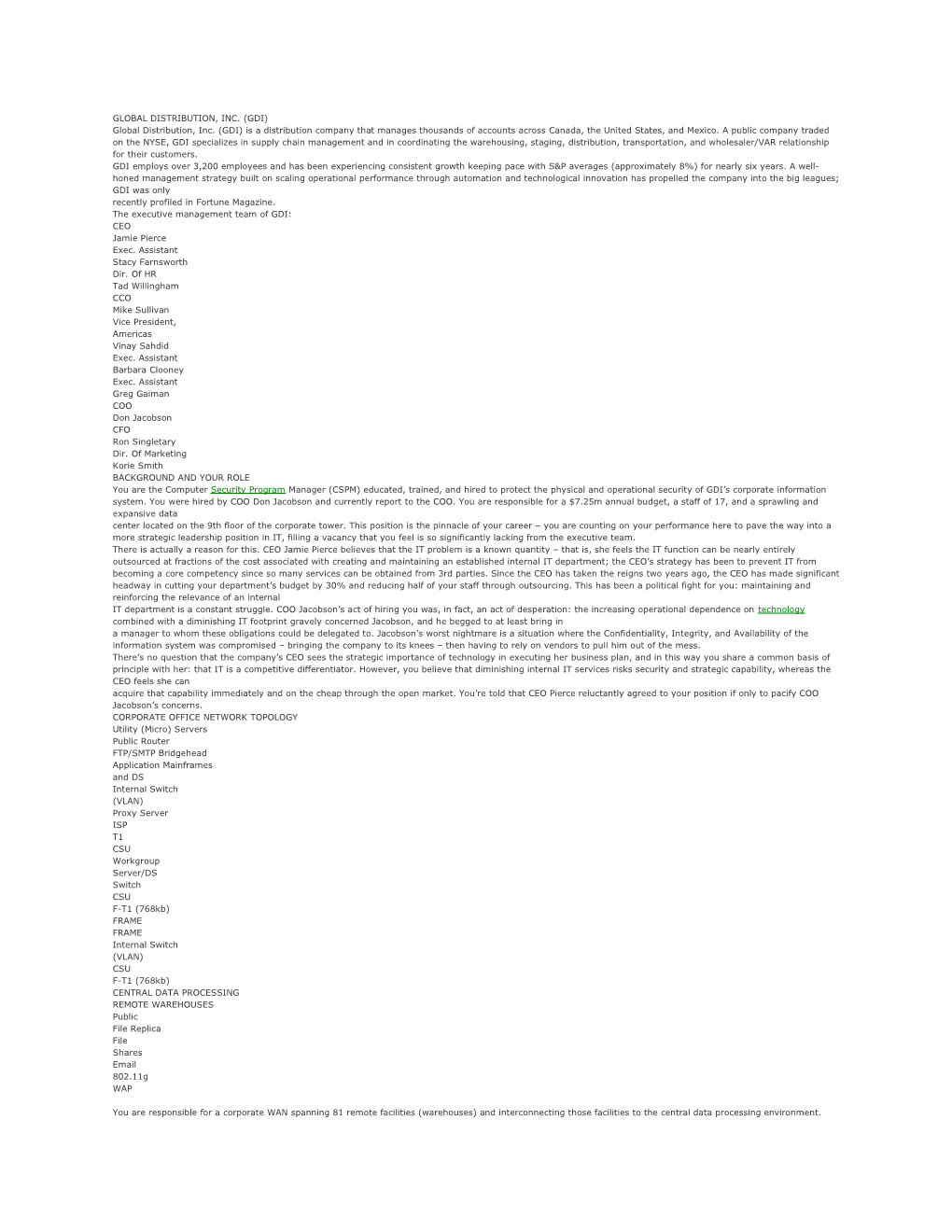GLOBAL DISTRIBUTION, INC. (GDI)
Global Distribution, Inc. (GDI) is a distribution company that manages thousands of accounts across Canada, the United States, and Mexico. A public company traded on the NYSE, GDI specializes in supply chain management and in coordinating the warehousing, staging, distribution, transportation, and wholesaler/VAR relationship for their customers.
GDI employs over 3,200 employees and has been experiencing consistent growth keeping pace with S&P averages (approximately 8%) for nearly six years. A well-honed management strategy built on scaling operational performance through automation and technological innovation has propelled the company into the big leagues; GDI was only
recently profiled in Fortune Magazine.
The executive management team of GDI:
CEO
Jamie Pierce
Exec. Assistant
Stacy Farnsworth
Dir. Of HR
Tad Willingham
CCO
Mike Sullivan
Vice President,
Americas
VinaySahdid
Exec. Assistant
Barbara Clooney
Exec. Assistant
Greg Gaiman
COO
Don Jacobson
CFO
Ron Singletary
Dir. Of Marketing
Korie Smith
BACKGROUND AND YOUR ROLE
You are the Computer Security Program Manager (CSPM) educated, trained, and hired to protect the physical and operational security of GDI’s corporate information system. You were hired by COO Don Jacobson and currently report to the COO. You are responsible for a $7.25m annual budget, a staff of 17, and a sprawling and expansive data
center located on the 9th floor of the corporate tower. This position is the pinnacle of your career – you are counting on your performance here to pave the way into a more strategic leadership position in IT, filling a vacancy that you feel is so significantly lacking from the executive team.
There is actually a reason for this. CEO Jamie Pierce believes that the IT problem is a known quantity – that is, she feels the IT function can be nearly entirely outsourced at fractions of the cost associated with creating and maintaining an established internal IT department; the CEO’s strategy has been to prevent IT from becoming a core competency since so many services can be obtained from 3rd parties. Since the CEO has taken the reigns two years ago, the CEO has made significant headway in cutting your department’s budget by 30% and reducing half of your staff through outsourcing. This has been a political fight for you: maintaining and reinforcing the relevance of an internal
IT department is a constant struggle. COO Jacobson’s act of hiring you was, in fact, an act of desperation: the increasing operational dependence on technology combined with a diminishing IT footprint gravely concerned Jacobson, and he begged to at least bring in
a manager to whom these obligations could be delegated to. Jacobson’s worst nightmare is a situation where the Confidentiality, Integrity, and Availability of the information system was compromised – bringing the company to its knees – then having to rely on vendors to pull him out of the mess.
There’s no question that the company’s CEO sees the strategic importance of technology in executing her business plan, and in this way you share a common basis of principle with her: that IT is a competitive differentiator. However, you believe that diminishing internal IT services risks security and strategic capability, whereas the CEO feels she can
acquire that capability immediately and on the cheap through the open market. You’re told that CEO Pierce reluctantly agreed to your position if only to pacify COO Jacobson’s concerns.
CORPORATE OFFICE NETWORK TOPOLOGY
Utility (Micro) Servers
Public Router
FTP/SMTP Bridgehead
Application Mainframes
and DS
Internal Switch
(VLAN)
Proxy Server
ISP
T1
CSU
Workgroup
Server/DS
Switch
CSU
F-T1 (768kb)
FRAME
FRAME
Internal Switch
(VLAN)
CSU
F-T1 (768kb)
CENTRAL DATA PROCESSING
REMOTE WAREHOUSES
Public
File Replica
File
Shares
Email
802.11g
WAP
You are responsible for a corporate WAN spanning 81 remote facilities (warehouses) and interconnecting those facilities to the central data processing environment. Data is transmitted from suppliers and customers through an FTP bridgehead server situated in the DMZ; files are encrypted and copied to the FTP server through automated replication; remote automation or users connect with the FTP server to transmit or receive encrypted EDI files.
A bulk of the data processing for your company is handled by twin IBM System/390 mainframes; all GL and financial functions are located on the mainframe platform; a microcomputer cluster manages email routing, file storage functions, HRIS, and other value-added applications; an application-layer proxy server serves as the central gateway for Internet connectivity for the corporate office and 81 remote sites – a strict philosophy of control, centralization, and outsourced services has guided much of the design of this network; GDI’ web server and e-commerce functions are hosted by an external party outside of the scope of this topology.
OTHER CONSIDERATIONS
1. Ever since the article ran in Fortune about GDI, your network engineers report that they’ve noted a significant spike in network traffic crossing into the DMZ. They report that they cannot be certain what or who is generating this traffic, but the volume and frequency of traffic is certainly abnormal.
2. Increasingly, GDI’s CEO Pierce attempts to outsource IT competency. In fact, you’ve been told of a plan from COO Jacobson to outsource network management functions away from your department and to a service integrator. COO Jacobson warns you that the political environment will only become more contentious over time; you must make a compelling case as to what value your department can bring over an integrator that can provide services at 40% less annual cost than you.
3. The interrelationship between data and operations concerns you. Increasingly, some of the 81 warehouses have been reporting significant problems with network latency, slow performance, and application time-outs against the System/390’s. The company’s business model is driving higher and higher demand for data, but your capability to respond to these problems are drastically limited.
ASSIGNMENT
1. Risk Assessment to include:
Identify the organizational assets
Assess the organizational risk
Describe the current organizational security posture
Describe the problems that GDI is having
Recommend a mitigation strategy
APA format
GLOBAL DISTRIBUTION, INC. (GDI) Global Distribution, Inc. (GDI) Is a Distribution Company
